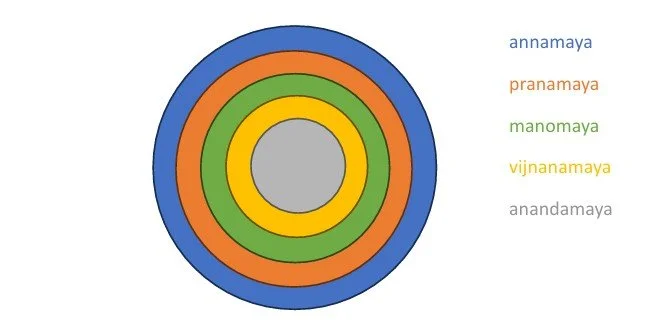The Pañcamaya
I have been thinking about the pañcamaya a lot lately. Three months ago I had knee replacement surgery. Reflection on the five layers of the body described in yoga philosophy helped me recover. You may have heard of the five kośas. These represent five layers, moving inward from the physical to the more and more subtle. They are:
Annamaya – the physical body (food/structure)
Prāņāmaya – energy, life force, breath
Manomaya – intellectual functions of the mind
Vijñānamaya – special knowledge specific to each of us, personality
Ānandamaya – emotions, feelings, our inner being
Although ‘kośa’ is translated to mean sheath or pocket, in reality ‘sponge’ is a better description. We can not work with one maya without touching the other four. They ‘bleed’ into each other. In the Taittiriya Upanisad, each maya is beautifully described using the model of a bird. For example, for annamaya/physical body, the head of the bird chooses direction, the body of the bird holds the parts together, the wings of the bird give flight and motion and the tail of the bird is the rudder used to implement balance and direction. This same model of a bird is thus used to describe the parts of each layer, which I won’t go into fully here.
In our yoga practice, we use physical āsana (annamaya) and breath (prāņāmaya) together, turning the mind (manomaya) inward to synchronise them. Each opening movement is an inhalation. Each closing movement an exhalation. I have often heard the phrase ‘meditation in motion’ describing this.
This practice of turning inward brings us closer to vijñānamaya, our personality. It is what makes us unique. It is made up of habits and deep beliefs developed through years of experiences. This is where inner transformation may occur through self reflection. Here the tail of the bird represents the baggage we carry. Self study unpacks the baggage. We can rip the negative out like weeds and replant new habits. If habits or beliefs are not good for us, instead of saying “don’t do that”, say “try to do this” instead.
Ānandamaya is the fifth layer and means infinite joy. We have all felt this at times when we are deeply connected to ourselves. The feeling is deep seeded and difficult to describe. We may feel it walking through nature or in company of a loved one. There is a sense of deep emotional connection. Although we perceive this as the innermost layer, it is not. A deeper layer is called cinmaya and represents pure consciousness, the deepest part of the Self. Ānandamaya and cinmaya are very close. The bliss (ānanda) permeates through to pure consciousness.
How does all this relate to my knee surgery? Dedicated physical therapy and āsana were required (annamaya). Breathing techniques helped overcome pain and gave energy (prāņāmaya). Mental focus in connecting to both breath and movement was meditative (manomaya). I underwent a transformation in my habits and beliefs in how I viewed what I could do in a yoga practice, and acceptance came (vijñānamaya). Finally, I had a moment of bliss at eight weeks post surgery when I climbed the Kennedy Range north of Gascoyne Junction, something I wouldn’t have been able to do before the surgery. The joy was indescribable and I felt it to my very core. I give credit to yoga and the philosophy of the pañcamaya.
The Pañcamaya
